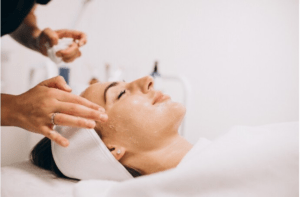Chemical peels have become increasingly popular as a cosmetic treatment to address various skin concerns, including uneven skin tone, acne scars, and signs of ageing. While these procedures offer significant benefits, it is crucial to prioritise safety considerations and take necessary precautions, especially when dealing with medical-grade chemical peels. This article aims to explore the essential safety guidelines for chemical peels, emphasising the importance of proper patient assessment, the role of healthcare professionals, potential complications, and post-peel care.
Chemical Peel Safety Guidelines
Before delving into the specific safety considerations, it’s paramount to understand the overarching chemical peel safety guidelines. These guidelines are designed to ensure the well-being of the patient throughout the entire process of chemical solution, from the initial assessment to the post-peel recovery phase.
Healthcare professionals should adhere to stringent protocols to minimise risks and complications associated with chemical peels. These guidelines encompass a thorough patient assessment, selection of appropriate peel type, and meticulous post-peel care. Adherence to these guidelines is essential to achieve optimal results while prioritising patient safety.
Understanding Chemical Peels
A chemical peel is a cosmetic treatment that involves the application of a chemical solution to the skin, causing controlled exfoliation and peeling of damaged skin cells. The purpose of this procedure is to remove damaged outer layers of skin, revealing smoother, rejuvenated skin underneath. Chemical peels vary in intensity, with superficial, medium, and deep peels addressing different skin concerns.
Chemical Peels
Superficial peels target the outer layer, while medium and deep peels penetrate deeper layers, stimulating collagen production and addressing more pronounced skin issues. The choice of a deep peel depends on the patient’s skin type, concerns, and desired outcomes.
Medium and Deep Peels
Medium and deep peels are particularly effective in addressing deep wrinkles, acne scars, and pigmentation issues. However, their intensity requires careful consideration and expertise to avoid adverse effects. Healthcare professionals must assess the patient’s suitability for these peels, considering factors such as skin type, medical history, and potential contraindications.
Deep Chemical Peel
Among the various types of peels, the deep chemical peel is the most intensive. It involves the use of strong acids like phenol to penetrate the middle layer of the skin. Deep chemical peels are known for their transformative effects but necessitate meticulous safety measures and post-peel care.
Importance of Patient Assessment
A thorough patient assessment is the foundation of safe and effective chemical peel procedures. Healthcare professionals must evaluate the patient’s skin type, medical history, and any existing skin conditions to determine the most suitable chemical peel and type and anticipate potential complications.
Skin Type and Concerns
Different skin types respond differently to chemical peels. Darker skin tones may be more prone to pigmentation issues, while lighter skin tones might be susceptible to prolonged redness. Understanding the patient’s skin type allows practitioners to tailor the amount of medium chemical peel to address specific concerns and minimise the risk of adverse effects.

Medical History and Contraindications
A comprehensive understanding of the patient’s medical history is crucial in identifying potential contraindications for chemical peels. Conditions such as herpes simplex infections (cold sores) may require antiviral medication before the procedure. Additionally, a history of keloid scarring may influence the choice of medium chemical peel and intensity.
Uneven Skin Tone and Pigmentation
Patients seeking chemical peels often cite uneven skin tone and pigmentation as primary concerns. Medium and deep peels, with their ability to penetrate deeper layers, can effectively address these issues. However, practitioners using medium chemical peels must carefully assess the patient’s skin to ensure the chosen peel type is appropriate for their specific concerns.
Role of Healthcare Professionals
Ensuring the safety of chemical peel procedures relies heavily on the expertise and diligence of healthcare professionals. From the initial consultation to the post-peel recovery, practitioners play a crucial role in minimising risks and optimising outcomes.
Proper Training and Expertise
Healthcare professionals performing chemical peels should have comprehensive training and expertise in dermatology or aesthetic medicine. This ensures a nuanced understanding of skin conditions, peel types, and potential complications. Practitioners lacking adequate training deep chemical peel, may inadvertently expose patients to increased risks.
Types of Chemical Peels
Understanding the different types of chemical peels is fundamental for healthcare professionals. Glycolic acid, salicylic acid, and trichloroacetic acid are commonly used in various peel formulations. Practitioners must be well-versed in the properties and applications of each acid to make informed decisions based on the patient’s skin type and concerns.
Deep Peel Considerations
Performing deep chemical peels demands a higher level of expertise due to the intensity of the procedure. Healthcare professionals should be experienced in handling deep chemical peels, to minimise the risk of complications such as scarring, persistent redness, and severe swelling. A meticulous approach and attention to detail are imperative in achieving optimal results while prioritising patient safety.
Potential Side Effects and Complications
Despite the meticulous adherence to safety guidelines, chemical peels carry inherent risks. Understanding potential side effects and complications is crucial for both healthcare professionals and patients, as it allows for proactive measures and effective management.
Skin Reaction and Texture Changes
Chemical peels stimulate skin renewal, which can lead to temporary changes in skin texture. It is essential to educate patients about these expected reactions to manage their expectations and alleviate concerns.
Sun Exposure and Post-Peel Care
Post-peel care is integral to achieving optimal results and preventing complications. Patients should be advised to avoid direct sun exposure and use broad-spectrum sunscreen regularly. Sun protection is critical in preventing pigmentation issues and ensuring the treated skin heals properly.
Acne Scars and Skin Disorders
Patients seeking chemical peels for acne scars or other skin disorders must be carefully evaluated. While chemical peels can effectively improve skin texture and tone, healthcare professionals should assess the severity of the condition and tailor the treatment plan accordingly. Additionally, patients with existing skin disorders require specialised care to prevent exacerbation.
Post-Peel Care and Maintenance
The success of a chemical peel extends beyond the procedure itself. Post-peel care and maintenance are vital for achieving lasting results and minimising potential complications.
Treated Skin and Damaged Skin Cells
Following a chemical peel, the treated skin is in a delicate state. Proper post-peel care involves gentle cleansing using a mild cleanser and the application of recommended post-peel creams. This promotes healing and prevents infection. Patients should avoid picking at peeling treated skin, to prevent damage to newly revealed skin cells.

Skin Heals and Alpha Hydroxy Acid
Understanding how the skin heals after a chemical peel is crucial for both practitioners and patients. The application of alpha hydroxy acid-containing products during the healing process can enhance results. However, patients must follow post-peel instructions diligently to get proper healing and avoid complications.
Types of Chemical Peels and Skin Penetration
Different types of deep chemical peels can penetrate the skin to varying depths. Superficial peels primarily target the outer layer, while medium and deep peels penetrate deeper layers. The depth of penetration influences the duration and intensity of post-peel care, emphasising the need for personalised care plans.
Specific Considerations for Different Skin Types
Recognizing that different skin types react differently to chemical peels is pivotal in ensuring individualised and effective treatment plans.
Darker Skin Tones
Patients with darker skin tones may be more susceptible to pigmentation issues post-peel. Healthcare professionals for black skin also must adjust peel intensity and post-peel care to minimise the risk of hyperpigmentation. Additionally, these patients should be informed about potential changes in skin colour during the healing process.
Medium Peels for All Skin Types
Medium peels can be suitable for a wide range of skin types and concerns. However, healthcare professionals must carefully assess each patient to determine the most appropriate peel formulation for skin colour and intensity. This individualised approach ensures optimal results without compromising safety.
Light and Medium Peels for Skin Conditions
Patients with specific skin conditions, such as acne or mild scarring, may benefit from light and medium peels. However, the choice of peel should align with the severity of the condition, and healthcare professionals should provide realistic expectations regarding the expected outcomes.
Explore our range of options tailored to meet your scar reduction needs.
Conclusion
Safety considerations and precautions are paramount when performing medical-grade chemical peels. Adhering to chemical peel safety guidelines, conducting thorough patient assessments, and prioritising post-peel care contribute to successful outcomes while minimising risks. Healthcare professionals play a pivotal role in ensuring patient safety, from choosing the appropriate and light chemical peel type to managing potential complications.
As the demand for cosmetic treatments continues to rise, a comprehensive understanding of chemical peels and their safety considerations is essential for both practitioners and patients. By fostering a collaborative and informed approach, the field of both aesthetic surgery and medicine can continue to deliver transformative results while prioritising the well-being of those seeking cosmetic enhancements.
Learn more about the effective treatments available at Eveon21.




